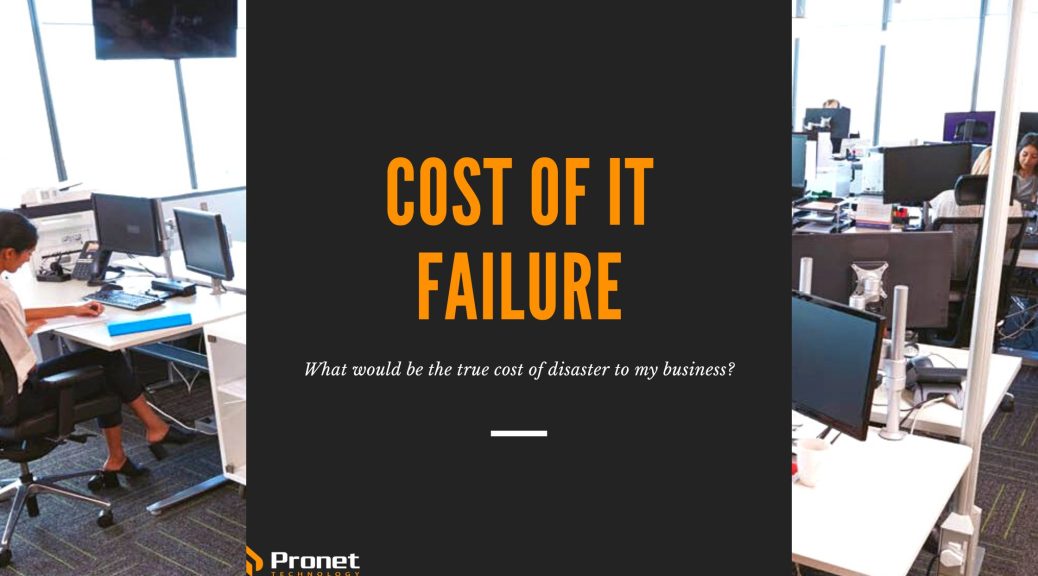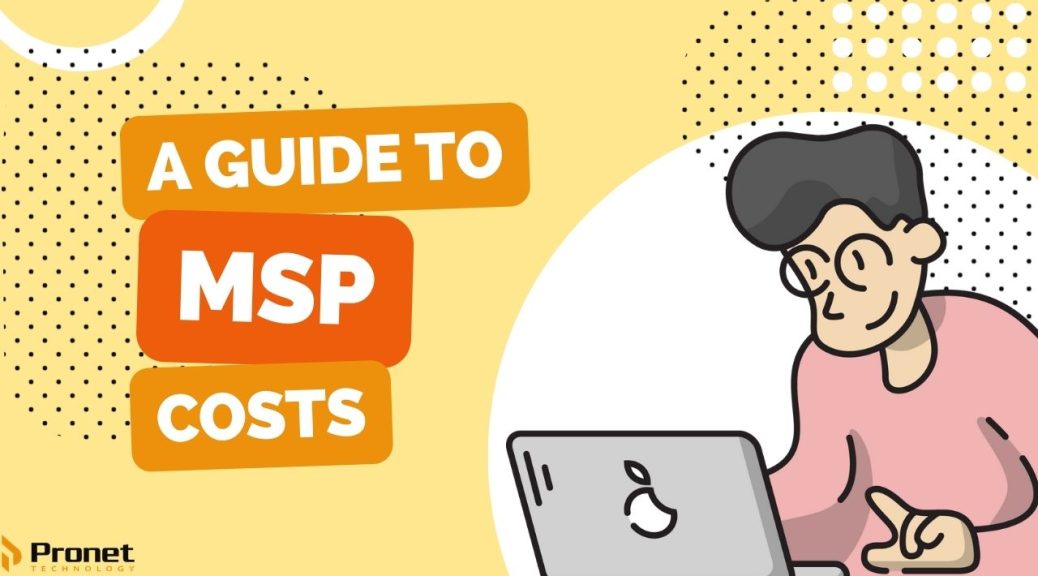What would be the true cost of disaster to my business if my IT failed?

As a business owner myself, I know the importance of keeping my business’ IT systems running smoothly, which I’m sure you are also aware of in your own company, but have you ever thought about the true cost of a disaster if your IT systems fail? The truth is that it can be catastrophic.
Imagine your business losing all of its data or being unable to access critical systems for a prolonged period. The impact on your business can be devastating, resulting in lost revenue, damage to your reputation and even the closure of your business.
So, what is the true cost of a disaster for your business if your IT fails? Measuring the cost of failure is complicated as there are so many different areas that factor into this, like direct costs and indirect costs.
Direct costs include costs of repairs or replacements of damaged hardware and software, as well as any business interruption. There is a range of indirect costs that IT system failures can create that can actually be higher than the direct costs. Let’s take a look at some of these:
Lost Revenue
The first factor people generally think of when they think of costs is lost revenue. Lost revenue occurs when a business is unable to continue normal business operations which can be incredibly devastating for businesses who heavily rely on technology. If your IT systems are down, your business may not be able to operate at full capacity, resulting in lost revenue.
Downtime also creates impatient customers and if other stores are selling similar products, customers will go there instead, to which they may find they like that store better, and therefore may continue using their products or services instead. Businesses need to understand the lifetime value of lost customers and when IT failures can cause your business to seem unreliable, this can tarnish the business’ reputation and therefore, lose customers.
The exact lost revenue from unplanned system outages depends on the type of outage and the size of your business. For a small independent store, an IT outage could result in no card payments for a few hours, leaving you relying only on cash — which not many people have on them these days. This is even more devastating for businesses that rely on every sale to stay afloat.
To calculate potential annual lost revenue, you can use a simple formula:
Lost Revenue = (G/T) x I x H
G = gross annual revenue
T = total annual business hours
I = percentage of revenue lost during an outage
H = number of annual outage hours

Reputation Damage
An indirect cost that occurs if your business experiences a significant IT failure can be a damaged reputation. Reputational damage occurs when customers and other stakeholders lose confidence in the organisation’s ability to effectively manage risks and protect their interests. Suppliers may also be hesitant to work with a business that has suffered a data breach, leading to potential supply chain disruptions and delays. If you’ve noticed the business’ reputation has been damaged, an entire marketing campaign may be needed to repair this, further incurring your business costs.
Customers may lose trust in your ability to provide reliable services or products, resulting in lost sales, and, as mentioned, lost customers occur when customers become frustrated with the disruption that occurs to businesses to which they then switch to a competitor, resulting in lost revenue.
Recovery Costs
Another direct cost associated with IT failures is the cost associated with fixing the issues. In the event of a disaster, you may need to hire IT professionals to restore your systems. This can be a costly process, especially if you need to pay for emergency services or if you don’t have a managed service provider.
Part of this also includes recovering or repurchasing hardware and software or services, which can differ in their severity. For example, a company’s email server not working is less severe than customers being unable to place orders. In this way, it’s the exact nature of the loss or outage that will determine the costs.
A factor that many people don’t think of are the costs surrounding overtime to catch up on missed work during downtime. Not only that, but IT failures may have forced your staff to keep paper records of transactions or notes during a system outage, which then need to be manually input when systems go online again, leading to overtime and other labour costs.
IT failures can also cause your staff to miss deadlines or follow through on contractual obligations with projects, meaning more money will be spent on projects that should have already been finished or you will have to reimburse customers.
Data Loss
Direct losses also include losing data, which has an even bigger impact on your business than the loss of an application or service. Data loss can be permanent and can have financial and legal implications beyond the direct losses on your company. The costs surrounding data loss can even lead to the closure of a business. Data loss ties into every other factor on this list and has a direct link to cyber threats like phishing, malware and ransomware. If your IT systems failed and cybercriminals had easy access to your network and data, this can also lead to ransom demands or costs related to recovering lost data.

Legal Costs
Depending on your industry, you may be subject to legal or regulatory requirements that mandate the protection of sensitive data. SMEs that suffer a data breach can face lawsuits and government fines, especially if they’re not in compliance with data protection laws. These legal battles can be expensive and time-consuming, and can also cause damage to your reputation.
Time and Productivity Loss
If your IT systems are down, your employees may not be able to work as efficiently. This can result in lost productivity and increased costs.
A Dunn & Bradstreet survey found that 59 per cent of Fortune 500 companies experience 1.6 hours of downtime per week or more. If this is a company-wide failure that prevents all employees from working and that company has 5,000 employees, with an average labour cost of $30 per hour, the labour downtime for that week is $240,000 in lost productivity. Per year, that’s $12,480,000. Even if you had one-thousandth of that amount, that’s still $12,480 per year just for outages.
In 2004, Gartner led a survey that found the average hourly cost of downtime for a mid-sized company was $42,000. They conducted the survey again in 2014 and this number had risen to $300,000 per hour. If they do the survey again next year, who knows how high this figure will have increased.
Keep in mind that this varies by industry, with financial organisations losing the highest amounts for every hour of downtime and these averages are heavily skewed by large organisations. In a recent survey of IT managers, only 20 per cent of companies had costs higher than $12,000 per hour.
Emotional Toll
Continued downtime, while affecting employee productivity, also affects morale, as when overtime is needed, this means more time away from families and their hobbies, and if this happens too often, staff will start looking for a new job.
IT failures and data loss also cause immense stress and anxiety for both business owners and employees. Cyberattacks that cause important business information to be lost, like customer details, financial information and inventory records can feel like a personal attack, especially when you’ve put so much time and effort into building your business. Disaster carries with it an emotional toll that takes a long time to recover from.

How to reduce the costs of a disaster to your business’ IT systems
So, what can you do to mitigate the risks of a disaster and protect your business? The answer is to invest in a comprehensive IT support plan that includes disaster recovery and business continuity. This type of plan can help ensure that your critical systems are backed up and can be restored quickly in the event of a disaster, and will help you and stakeholders understand how affected your business will be if anything occurs and also give you a path forward for how to reduce these risks.
In addition to disaster recovery, your IT support plan should include regular system maintenance, security updates and proactive monitoring to prevent issues before they occur. Partnering with an IT service provider that specialises in data security can also be a wise investment. These providers can help identify vulnerabilities in your system and implement security measures to protect your business from data loss. They can also provide ongoing support and monitoring to ensure that your systems are secure and up-to-date.
It’s also important to educate your employees about data security and implement security measures such as firewalls, antivirus software and multi-factor authentication, as well as by implementing the Australian Government’s recommended Essential Eight Cyber Security measures. By investing in a comprehensive IT support plan, you can help minimise the risk of a disaster and protect your business from the potentially catastrophic costs of an IT failure.
There’s no point in pretending your IT systems will never fail. Over the years of using a personal computer, we all know that’s not possible, and this is the same for IT systems in business landscapes. No organisation will experience no downtime, but as long as practices are followed that keep downtime to a minimum, then you can feel reassured that everything will be okay in the long run.
An IT service provider can be monumental in helping with preventing risks from occurring within your business. Your business probably already has one, but make sure you’re constantly keeping in communication with them to ensure they’re properly looking after your business’ interests.
If your business is not with a provider or you’re looking to switch, give us at Pronet a call to see if we’re the right fit for you.







